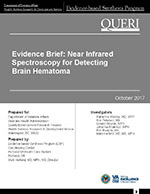
Investigators: Katherine Mackey, MD, MPP; Kim Peterson, MS; Donald Bourne, MPH; Johanna Anderson, MPH; Erin Boundy, MS; Mark Helfand, MD, MS, MPH
Download PDF: Complete Report, Executive summary, Supplemental materials
The aim of this evidence brief is to evaluate the potential impact of near infrared spectroscopy (NIRS) use among nursing home patients after falls by describing the technical feasibility of NIRS for detecting brain hematomas and synthesizing the evidence on the performance characteristics of NIRS, and its impact on diagnostic and therapeutic decision-making, patient outcomes, potential harms, and cost-effectiveness.
KQ1: What are the performance characteristics of NIRS as a diagnostic test for patients with mild TBI suspected of having a brain hematoma or with risk factors for brain hematoma?
KQ2: What is the evidence that use of NIRS impacts diagnostic and/or therapeutic decision-making for patients suspected of having a brain hematoma or with risk factors for brain hematoma?
KQ3: What is the evidence that use of NIRS to detect brain hematomas impacts patient outcomes?
KQ4: What are potential adverse effects and unintended consequences of using NIRS for detection of brain hematoma?
KQ5: What is the cost-effectiveness of using NIRS for detecting brain hematoma?
KQ6: Do the effects of NIRS vary by patient population or setting?
Evidence Brief: Near Infrared Spectroscopy for Detecting Brain Hematoma (Management eBrief)